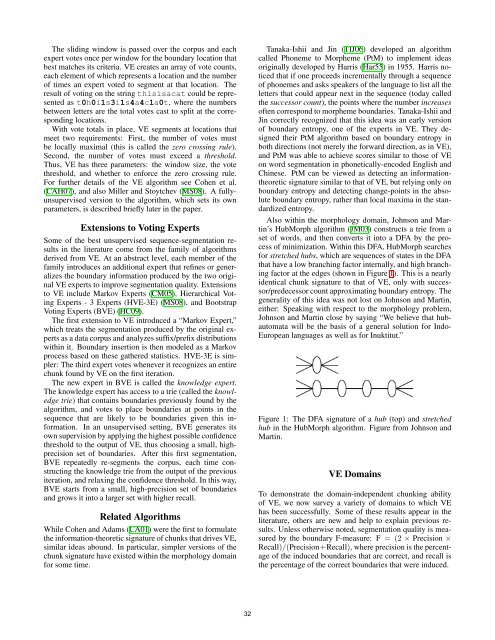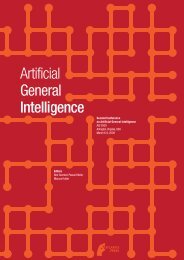Advances in Intelligent Systems Research - of Marcus Hutter
Advances in Intelligent Systems Research - of Marcus Hutter
Advances in Intelligent Systems Research - of Marcus Hutter
You also want an ePaper? Increase the reach of your titles
YUMPU automatically turns print PDFs into web optimized ePapers that Google loves.
The slid<strong>in</strong>g w<strong>in</strong>dow is passed over the corpus and each<br />
expert votes once per w<strong>in</strong>dow for the boundary location that<br />
best matches its criteria. VE creates an array <strong>of</strong> vote counts,<br />
each element <strong>of</strong> which represents a location and the number<br />
<strong>of</strong> times an expert voted to segment at that location. The<br />
result <strong>of</strong> vot<strong>in</strong>g on the str<strong>in</strong>g thisisacat could be represented<br />
as t0h0i1s3i1s4a4c1a0t, where the numbers<br />
between letters are the total votes cast to split at the correspond<strong>in</strong>g<br />
locations.<br />
With vote totals <strong>in</strong> place, VE segments at locations that<br />
meet two requirements: First, the number <strong>of</strong> votes must<br />
be locally maximal (this is called the zero cross<strong>in</strong>g rule).<br />
Second, the number <strong>of</strong> votes must exceed a threshold.<br />
Thus, VE has three parameters: the w<strong>in</strong>dow size, the vote<br />
threshold, and whether to enforce the zero cross<strong>in</strong>g rule.<br />
For further details <strong>of</strong> the VE algorithm see Cohen et al.<br />
(CAH07), and also Miller and Stoytchev (MS08). A fullyunsupervised<br />
version to the algorithm, which sets its own<br />
parameters, is described briefly later <strong>in</strong> the paper.<br />
Extensions to Vot<strong>in</strong>g Experts<br />
Some <strong>of</strong> the best unsupervised sequence-segmentation results<br />
<strong>in</strong> the literature come from the family <strong>of</strong> algorithms<br />
derived from VE. At an abstract level, each member <strong>of</strong> the<br />
family <strong>in</strong>troduces an additional expert that ref<strong>in</strong>es or generalizes<br />
the boundary <strong>in</strong>formation produced by the two orig<strong>in</strong>al<br />
VE experts to improve segmentation quality. Extensions<br />
to VE <strong>in</strong>clude Markov Experts (CM05), Hierarchical Vot<strong>in</strong>g<br />
Experts - 3 Experts (HVE-3E) (MS08), and Bootstrap<br />
Vot<strong>in</strong>g Experts (BVE) (HC09).<br />
The first extension to VE <strong>in</strong>troduced a “Markov Expert,”<br />
which treats the segmentation produced by the orig<strong>in</strong>al experts<br />
as a data corpus and analyzes suffix/prefix distributions<br />
with<strong>in</strong> it. Boundary <strong>in</strong>sertion is then modeled as a Markov<br />
process based on these gathered statistics. HVE-3E is simpler:<br />
The third expert votes whenever it recognizes an entire<br />
chunk found by VE on the first iteration.<br />
The new expert <strong>in</strong> BVE is called the knowledge expert.<br />
The knowledge expert has access to a trie (called the knowledge<br />
trie) that conta<strong>in</strong>s boundaries previously found by the<br />
algorithm, and votes to place boundaries at po<strong>in</strong>ts <strong>in</strong> the<br />
sequence that are likely to be boundaries given this <strong>in</strong>formation.<br />
In an unsupervised sett<strong>in</strong>g, BVE generates its<br />
own supervision by apply<strong>in</strong>g the highest possible confidence<br />
threshold to the output <strong>of</strong> VE, thus choos<strong>in</strong>g a small, highprecision<br />
set <strong>of</strong> boundaries. After this first segmentation,<br />
BVE repeatedly re-segments the corpus, each time construct<strong>in</strong>g<br />
the knowledge trie from the output <strong>of</strong> the previous<br />
iteration, and relax<strong>in</strong>g the confidence threshold. In this way,<br />
BVE starts from a small, high-precision set <strong>of</strong> boundaries<br />
and grows it <strong>in</strong>to a larger set with higher recall.<br />
Related Algorithms<br />
While Cohen and Adams (CA01) were the first to formulate<br />
the <strong>in</strong>formation-theoretic signature <strong>of</strong> chunks that drives VE,<br />
similar ideas abound. In particular, simpler versions <strong>of</strong> the<br />
chunk signature have existed with<strong>in</strong> the morphology doma<strong>in</strong><br />
for some time.<br />
Tanaka-Ishii and J<strong>in</strong> (TIJ06) developed an algorithm<br />
called Phoneme to Morpheme (PtM) to implement ideas<br />
orig<strong>in</strong>ally developed by Harris (Har55) <strong>in</strong> 1955. Harris noticed<br />
that if one proceeds <strong>in</strong>crementally through a sequence<br />
<strong>of</strong> phonemes and asks speakers <strong>of</strong> the language to list all the<br />
letters that could appear next <strong>in</strong> the sequence (today called<br />
the successor count), the po<strong>in</strong>ts where the number <strong>in</strong>creases<br />
<strong>of</strong>ten correspond to morpheme boundaries. Tanaka-Ishii and<br />
J<strong>in</strong> correctly recognized that this idea was an early version<br />
<strong>of</strong> boundary entropy, one <strong>of</strong> the experts <strong>in</strong> VE. They designed<br />
their PtM algorithm based on boundary entropy <strong>in</strong><br />
both directions (not merely the forward direction, as <strong>in</strong> VE),<br />
and PtM was able to achieve scores similar to those <strong>of</strong> VE<br />
on word segmentation <strong>in</strong> phonetically-encoded English and<br />
Ch<strong>in</strong>ese. PtM can be viewed as detect<strong>in</strong>g an <strong>in</strong>formationtheoretic<br />
signature similar to that <strong>of</strong> VE, but rely<strong>in</strong>g only on<br />
boundary entropy and detect<strong>in</strong>g change-po<strong>in</strong>ts <strong>in</strong> the absolute<br />
boundary entropy, rather than local maxima <strong>in</strong> the standardized<br />
entropy.<br />
Also with<strong>in</strong> the morphology doma<strong>in</strong>, Johnson and Mart<strong>in</strong>’s<br />
HubMorph algorithm (JM03) constructs a trie from a<br />
set <strong>of</strong> words, and then converts it <strong>in</strong>to a DFA by the process<br />
<strong>of</strong> m<strong>in</strong>imization. With<strong>in</strong> this DFA, HubMorph searches<br />
for stretched hubs, which are sequences <strong>of</strong> states <strong>in</strong> the DFA<br />
that have a low branch<strong>in</strong>g factor <strong>in</strong>ternally, and high branch<strong>in</strong>g<br />
factor at the edges (shown <strong>in</strong> Figure 1). This is a nearly<br />
identical chunk signature to that <strong>of</strong> VE, only with successor/predecessor<br />
count approximat<strong>in</strong>g boundary entropy. The<br />
generality <strong>of</strong> this idea was not lost on Johnson and Mart<strong>in</strong>,<br />
either: Speak<strong>in</strong>g with respect to the morphology problem,<br />
Johnson and Mart<strong>in</strong> close by say<strong>in</strong>g “We believe that hubautomata<br />
will be the basis <strong>of</strong> a general solution for Indo-<br />
European languages as well as for Inuktitut.”<br />
Figure 1: The DFA signature <strong>of</strong> a hub (top) and stretched<br />
hub <strong>in</strong> the HubMorph algorithm. Figure from Johnson and<br />
Mart<strong>in</strong>.<br />
VE Doma<strong>in</strong>s<br />
To demonstrate the doma<strong>in</strong>-<strong>in</strong>dependent chunk<strong>in</strong>g ability<br />
<strong>of</strong> VE, we now survey a variety <strong>of</strong> doma<strong>in</strong>s to which VE<br />
has been successfully. Some <strong>of</strong> these results appear <strong>in</strong> the<br />
literature, others are new and help to expla<strong>in</strong> previous results.<br />
Unless otherwise noted, segmentation quality is measured<br />
by the boundary F-measure: F = (2 × Precision ×<br />
Recall)/(Precision+Recall), where precision is the percentage<br />
<strong>of</strong> the <strong>in</strong>duced boundaries that are correct, and recall is<br />
the percentage <strong>of</strong> the correct boundaries that were <strong>in</strong>duced.<br />
32













